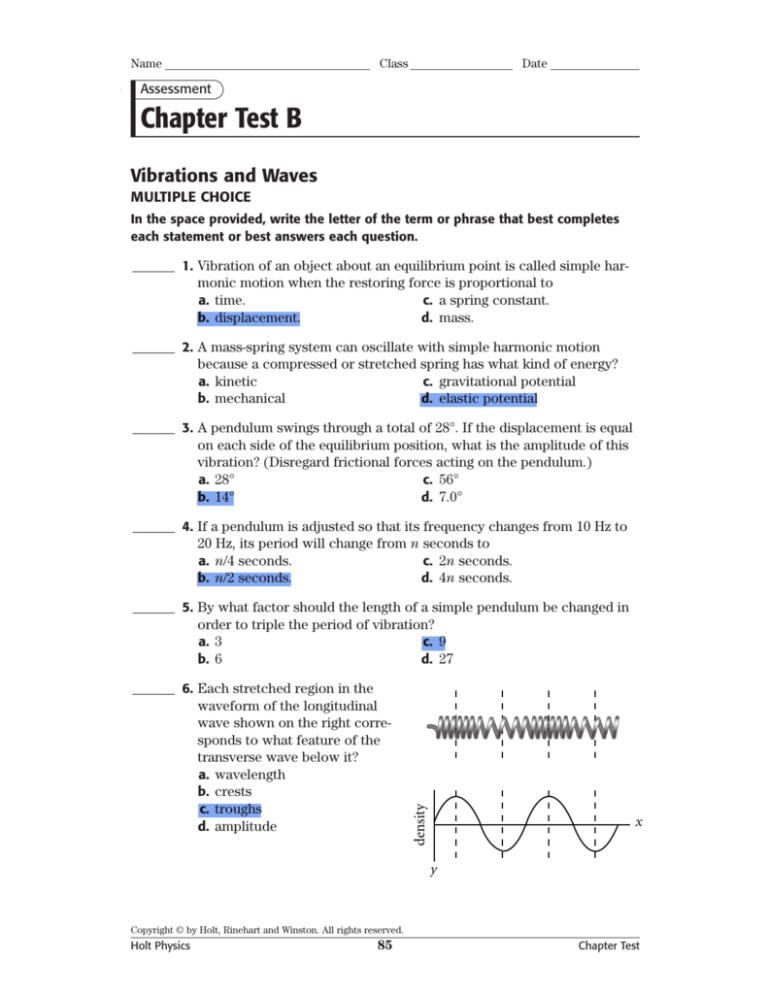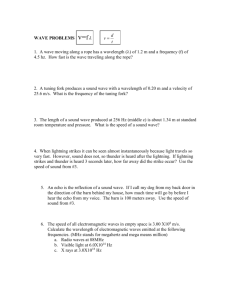
Name
Class
Date
Assessment
Chapter Test B
Vibrations and Waves
MULTIPLE CHOICE
In the space provided, write the letter of the term or phrase that best completes
each statement or best answers each question.
______ 1. Vibration of an object about an equilibrium point is called simple harmonic motion when the restoring force is proportional to
a. time.
c. a spring constant.
b. displacement.
d. mass.
______ 2. A mass-spring system can oscillate with simple harmonic motion
because a compressed or stretched spring has what kind of energy?
a. kinetic
c. gravitational potential
b. mechanical
d. elastic potential
______ 3. A pendulum swings through a total of 28°. If the displacement is equal
on each side of the equilibrium position, what is the amplitude of this
vibration? (Disregard frictional forces acting on the pendulum.)
a. 28°
c. 56°
b. 14°
d. 7.0°
______ 4. If a pendulum is adjusted so that its frequency changes from 10 Hz to
20 Hz, its period will change from n seconds to
a. n/4 seconds.
c. 2n seconds.
b. n/2 seconds.
d. 4n seconds.
______ 6. Each stretched region in the
waveform of the longitudinal
wave shown on the right corresponds to what feature of the
transverse wave below it?
a. wavelength
b. crests
c. troughs
d. amplitude
density
______ 5. By what factor should the length of a simple pendulum be changed in
order to triple the period of vibration?
a. 3
c. 9
b. 6
d. 27
x
y
Copyright © by Holt, Rinehart and Winston. All rights reserved.
Holt Physics
85
Chapter Test
Name
Class
Date
Chapter Test B continued
______ 7. Suppose that two sound waves passing through the same medium have
different wavelengths. Which of the following is most likely to be the
reason for the differing wavelengths?
a. the nature of the medium
c. differences in frequency
b. differences in amplitude
d. the type of wave
______ 8. When a mechanical wave’s amplitude is reduced by half, the energy
the wave carries in a given time interval is
a. doubled.
c. decreased to one-half.
b. increased by a factor of 1.4.
d. decreased to one-fourth.
______ 9. Two waves traveling in opposite directions on a rope meet and undergo
complete destructive interference. Which of the following best
describes the waves a moment after the waves meet and coincide?
a. The waves no longer exist.
b. The waves continue unchanged.
c. The waves reflect and travel backward.
d. A single wave continues along the rope.
______10. Which of the following types of interference will occur when the
pulses in the figure above meet?
a. no interference
c. partial destructive
b. complete constructive
d. complete destructive
______11. Consider two identical wave pulses on a rope having a fixed end.
Suppose the first pulse reaches the end of the rope, is reflected back,
and then meets the second pulse. When the two pulses overlap exactly,
what will be the amplitude of the resultant pulse?
a. zero
b. same as the original pulses
c. double the amplitude of the original pulses
d. half the amplitude of the original pulses
______12. A 2.0 m long stretched rope is fixed at both ends. Which wavelength
would not produce standing waves on this rope?
a. 2.0 m
c. 4.0 m
b. 3.0 m
d. 6.0 m
Copyright © by Holt, Rinehart and Winston. All rights reserved.
Holt Physics
86
Chapter Test
Name
Class
Date
Chapter Test B continued
______13. A 3.0 m long stretched string is fixed at both ends. If standing waves
with a wavelength of two-thirds L are produced on this string, how
many nodes will be formed?
a. 0
c. 3
b. 2
d. 4
SHORT ANSWER
14. In an oscillating mass-spring system, the restoring force is a result of the force
exerted by the spring. What causes the restoring force in a swinging pendulum?
Component of gravity which changes with displacement
15. If a spring is stretched from a displacement of 10 cm to a displacement of 30 cm,
the force exerted by the spring increases by a factor of
.
three
16. In an old-fashioned pendulum clock, the bob is moved up and down to adjust
the clock to keep accurate time. How would you adjust the bob in order to
correct a clock that runs too fast? Explain why the adjustment works.
Bring it down, thus increasing the period and slowing the clock down.
17. A boat produces a wave as it passes an aluminum can floating in a lake.
Explain why the can is not moved along in the direction of wave motion.
The wave doesn't carry on particles - only vibrations. So the can will move with the wave - it will oscillate
18. What is the difference between a pulse wave and a periodic wave?
A pulse wave is one, single vibration.
Copyright © by Holt, Rinehart and Winston. All rights reserved.
Holt Physics
87
Chapter Test
Name
Class
Date
Chapter Test B continued
19. What feature of a wave increases when the source of vibration increases in
energy?
Amplitude
20. A standing wave is produced by plucking a string. The points along the
plucked string that appear not to be vibrating are produced by
interference.
Complete destructive interference.
PROBLEM
21. A mass on a spring that has been compressed 0.1 m has a restoring force of
20 N. What is the spring constant?
200 N/m
22. A car with bad shock absorbers bounces up and down after hitting a bump.
The car has a mass of 1500 kg and is supported by four springs, each having a
spring constant of 6600 N/m. What is the period for each spring?
1.5 s
23. A student wishes to construct a mass-spring system that will oscillate with the
same frequency as a swinging pendulum with a period of 3.45 s. The student
has a spring with a spring constant of 72.0 N/m. What mass should the student
use to construct the mass-spring system?
21.7 kg
24. Radio waves from an FM station have a frequency of 103.1 MHz. If the waves
travel with a speed of 3.00 ! 108 m/s, what is the wavelength?
2. 91m
25. Vibration of a certain frequency produces a standing wave on a stretched
string that is 2.0 m long. The standing wave has 7 nodes and 5 antinodes.
What is the wavelength of the wave that produces this standing wave?
Copyright © by Holt, Rinehart and Winston. All rights reserved.
Holt Physics
88
Chapter Test









